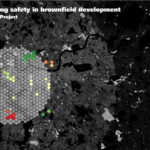A new report published by Atkins, a member of the SNC-Lavalin Group, shows how data can be used to help us better understand brownfield sites and make it easier to bring them forward for development.
The report discusses the findings of a discovery project undertaken by Atkins and the Open Data Institute and funded by Lloyds Register Foundation. The project examines how much information current open datasets give us on brownfield sites, particularly around land contamination, where the gaps are and where those gaps could be filled by other ‘closed’ datasets.
Dr Caroline Paradise, Head of Design Research at Atkins, said: “There are over 1.1. million households in England on the social housing waiting list, even though we have enough brownfield land to build an estimated one million homes, as per a report by Atkins’ housing development arm EDAROTH. Bringing this land forward for development is imperative, but we can’t do that without data. This report identifies some key areas where we are missing data and, crucially, where that data already exists — if we are willing to share it.”
EDAROTH provides end-to-end social and affordable housing solutions focusing on brownfield land which is often considered too difficult or expensive to develop.
One of the blockers in developing these sites is unknown ground conditions, especially where there is the potential for land contamination. Atkins’ report shows that some important datasets used in land contamination risk assessment are only available from non-open data sources, which impacts the risk assessment outcomes for a site. Opening these datasets could help improve decision making and reduce the costs associated with developing brownfield sites.
Jeni Tennison, Vice President at the ODI, commented: “The UK’s new National Data Strategy highlights the importance of increasing data availability, and the Geospatial Strategy emphasises the power of location data. This work shows these principles in action: how open data could speed up the development of brownfield sites and help meet the UK’s housing needs. This is a great opportunity for industry and government to collaborate and unlock the potential of location data.”
In addition to helping the UK tackle its housing crisis, open data used in land contamination risk assessment would also help deliver the ambitions in the UK’s Geospatial Data Strategy.
he report introduces an inventory of data currently used in land contamination risk assessment, as well as case studies into open and closed datasets. It also creates a framework to encourage increased sharing of data on land contamination.
The report is part of Lloyd’s Register Foundation and the ODI’s stimulus fund for projects that increase access to data and drive innovation in the engineering sector. It can be downloaded here.
Earlier this year EDAROTH released research on the importance of brownfield development. More information on the reseach here: https://labmonline.co.uk/news/new-research-on-the-importance-of-brownfield-development/









